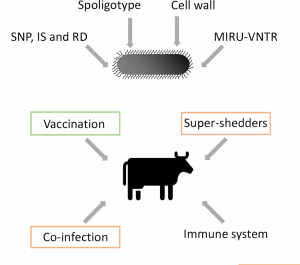
André C. Pereira, Ana C. Reis, Beatriz Ramos, and Mónica V. Cunha
Animal tuberculosis (TB) in terrestrial mammals is mainly caused by Mycobacterium bovis. This pathogen is adapted to a wide range of host species, representing a threat to livestock, wildlife and human health. Disease heterogeneity is a hallmark of multi‐host TB and a challenge for control. Drivers of animal TB heterogeneity are very diverse and may act at the level of the causative agent, the host species, the interface between mycobacteria and the host, community of hosts, the environment and even policy behind control programmes. In this paper, we examine the drivers that seem to contribute to this phenomenon. We begin by reviewing evidence accumulated to date supporting the consensus that a complex range of genetic, biological and socio‐environmental factors contribute to the establishment and maintenance of animal TB, setting the grounds for heterogeneity. We then highlight the complex interplay between individual, species‐specific and community protective factors with risk/maintenance variables that include animal movements and densities, co‐infection and super‐shedders. We finally consider how current interventions should seek to consider and explore heterogeneity in order to tackle potential limitations for diagnosis and control programmes, simultaneously increasing their efficacy.
Doi: 10.1111/tbed.13539
Cited as: Pereira AC, Reis AC, Ramos B, Cunha MV (2020). Animal tuberculosis: Impact of disease heterogeneity in transmission, diagnosis and control. Transbound Emerg Dis. 67:1828–1846; doi: https://doi.org/10.1111/tbed.13539.



